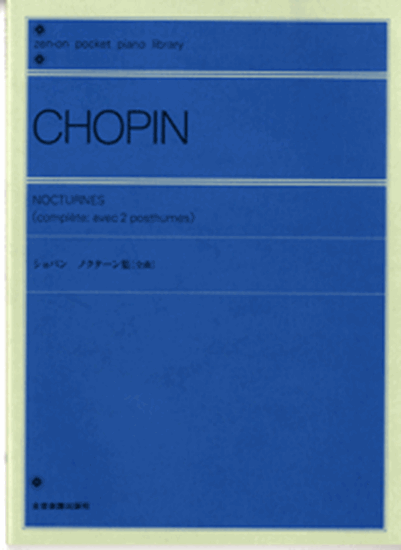Chopin, Frederic : Nocturne No.12 G-Dur Op.37-2
Work Overview
Genre:nocturne
Total Playing Time:5 min 30 sec
Copyright:Public Domain
Commentary (1)
Author : Higuchi, Akiko
Last Updated: February 9, 2019
[Open]
Author : Higuchi, Akiko
Deux Nocturnes, Op. 37
These two nocturnes were composed between 1838 and 1839, and their first editions were published in Paris (Troupenas, 1840), Leipzig (Breitkopf und Härtel, 1840), and London (Wessel, 1840). No dedicatee is mentioned. It is believed that these two pieces were composed around the time of Chopin's sea voyage to Mallorca with George Sand, who was a popular female writer and his lover at the time. Although the connection between this experience and the present work is uncertain, the second nocturne features a barcarolle-like section.
No. 2 in G Major
This nocturne can be recognized as having a rondo-like form: A, B, A’, B’, A’’, Coda. However, it is characteristic that modulations occur extremely frequently throughout the piece, with the tonic key of G major appearing only rarely. For example, in section A, G major appears only momentarily in mm. 1-3, mm. 6-7, and mm. 21-22.
In section A, the right-hand theme, consisting of double notes such as thirds and sixths, is characteristic, played over a left-hand arpeggiated accompaniment pattern that includes large leaps. Among Chopin's 21 nocturnes, this is the only one where the theme is presented with double notes from the very beginning. These rapid successions of thirds and sixths create a brilliant sonic effect while also imparting an etude-like aspect to the piece.
In contrast, in section B, a plain, simple barcarolle-like theme is played, supported by dotted half notes in the left hand. Although the outline of the theme is patterned, like section A, it freely modulates one after another, and the sound of G major is even less audible here than in A. Tracing its modulation process, it reaches C major (m. 28-), E major (m. 36-), C-sharp major (momentary, m. 45), F-sharp minor (m. 46-), A-flat minor (m. 48-), F major (m. 51-), B-flat major (m. 53-), D major (m. 60-), and finally G major (m. 66-). Modulations by a major third to keys a major third above, such as from C major to E major, and from B-flat major to D major, were favored by Chopin.
Following this, A’ (and similarly A’’) is a condensed version of A, while B’ is the same length as B but has a different modulation progression. In A’, expected cadences are successively thwarted by the chromatically ascending bass, fostering a rambling atmosphere (mm. 81-85). This B’ also includes keys quite distant from G major, such as G-sharp major (mm. 91-97) and A-sharp minor (mm. 98-102). In the Coda after the fermata at m. 132, a portion of the B theme, which never appeared as a theme in G major in section B, is played in G major, and the piece concludes with a ppp V-I harmonic progression in G major.
PTNA & Partner Channel Videos(4items)
Sheet Music
Scores List (15)

(株)全音楽譜出版社

(株)全音楽譜出版社

(株)全音楽譜出版社

(株)全音楽譜出版社

ハンナ(ショパン)

(株)ドレミ楽譜出版社

(株)音楽之友社

(株)全音楽譜出版社

(株)音楽之友社

(株)全音楽譜出版社

(株)全音楽譜出版社

(株)全音楽譜出版社

ポーランド音楽出版社

(株)ヤマハミュージックエンタテインメントホールディングス

(株)音楽之友社




